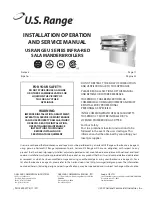
18
107110-01 - 6/16
Vii. Venting
A. Vent System Design (continued)
7. Supporting Pipe - Vertical and horizontal sections of pipe must be properly supported. Maximum support spacing is as
follows:
• Support CPVC/PVC horizontally and vertically every 4 feet.
• Support DuraVent PolyPro horizontally near the female end of each straight section of pipe and vertically every 10 feet.
• Support Centrotherm InnoFlue horizontally every 39 inches with additional supports at elbows and vertically every 78”.
• Support 2” Selkirk Polyflue horizontally every 30”. Support 3” Polyflue horizontally every 39”. Support vertical runs of
both 2” and 3” Polyflue every 16 ft.
Les instructions d´installation du système d´évacuation doivent préciser que les sections horizontales doivent être
supportées pour prévenir le fléchissement. Les méthodes et les intervalles de support doivent être spécifiés. Les
instructions divent aussi indiquer les renseignements suivants:
• les chaudières de catégories II et IV doivent être installées de façon à empêcher l´accumulation de condensat: et
• si nécessaire, les chaudières de catégories II et IV doivent être pourvues de dispositifs d´évacuation du condensat.
8. Allowing for Thermal Expansion -
• For CPVC/PVC pipe design, the vent system shall allow 3/8” of thermal expansion for every 10ft of CPVC/PVC pipe.
The boiler will always act as an anchor to one end of the vent system. If at all possible, select and install hangers and
wall thimbles so that the vent system can expand towards the terminal. When a straight run of pipe exceeds 20ft and
must be restrained at both ends, an offset or expansion loop must be provided (Figures 7.3a, 7.3b). When a straight
horizontal run of pipe exceeds 20ft and is restrained at one end with an elbow at the other, avoid putting a hanger or
guide less than “Y” inches from the elbow in the adjoining straight section (Figure 7.3c). Thermal expansion fittings
are not permitted.
• When properly assembled expansion of PolyPro, Polyflue and InnoFlue vent systems is accommodated at the joints. See
Section VII - F, G & H of this manual for details.
9. Running PVC Vent Pipe Inside Enclosures and Through Walls - PVC vent pipe must be installed in a manner that permits
adequate air circulation around the outside of the pipe:
• Do not enclose PVC venting - Use CPVC in enclosed spaces, even if PVC is installed upstream.
• PVC venting may not be used to penetrate combustible or non-combustible walls unless all of the following conditions
are met:
a. The wall penetration is at least 66 inches from the boiler as measured along the vent.
b. The wall is 12” thick or less
c. An airspace of at least that shown in Figure 7.4 is maintained around the OD of the vent.
If any of these conditions cannot be met, use CPVC for the wall penetration.
10.
Vent Manufacturer’s Instructions
– The vent system manufacturer may have additional vent system design requirements.
Read and follow the vent manufacturer’s instructions in addition to those shown here. Where a conflict arises between the
two sets of instructions, the more restrictive requirements shall govern.
Summary of Contents for K2WT
Page 82: ...82 107110 01 6 16 Figure 10 4 Proper Installation of Header Sensor X Wiring continued ...
Page 83: ...83 107110 01 6 16 X Wiring continued Figure 10 5 Internal Ladder Diagram ...
Page 84: ...84 107110 01 6 16 X Wiring continued ...
Page 85: ...85 107110 01 6 16 Figure 10 6 Internal Wiring Connections Diagram X Wiring continued ...
Page 95: ...95 107110 01 6 16 Lighting and Operating Instructions XI Start Up and Checkout continued ...
Page 140: ...140 107110 01 6 16 XV Repair Parts continued ...
Page 142: ...142 107110 01 6 16 XV Repair Parts continued ...
Page 146: ...146 107110 01 6 16 XV Repair Parts continued ...
Page 148: ...148 107110 01 6 16 XV Repair Parts continued ...
Page 161: ...161 107110 01 6 16 ...
Page 162: ...162 107110 01 6 16 ...
Page 163: ...163 107110 01 6 16 ...
















































